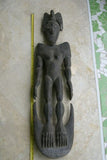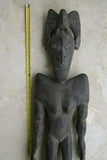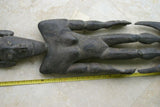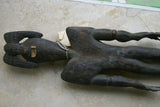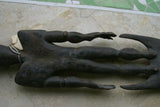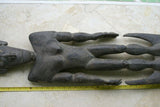Older Middle Sepik Tribal Ancestor Hand Carved Suspension Hook 30A9 Guinea 40"
Large Suspension hook
Authentic, with a mystical symbolic protective ancestor Clan bird on its head
It was collected in the field along the Sepik River in PNG.
MORE THAN 3 FT TALL
Detailed piece: 40" tall x 10" wide x 4"
ITEM 30A9 in our inventory
This food hook also works as a magical shield, generally protecting from bad magic worked against the village by marauding demons (Maselei) or magic generated by enemy sorcerers (Sanguma).
The story from where some of these characters are drawn often refers to secret tales only known by the tribal elders. The figure was hand carved out of one solid piece of wood. The eyes are shells incrusted into the hand carving.
Such figures are imbibed with the magic to protect the village from bad magic worked against it by enemy sorcerers (Samguma).
The basket hook is attached to the rafters with a length of split cane (Kanda) and a wide, flat piece of bark is threaded onto the cane to prevent the rats from climbing down from the rafters to the food.
Cult hooks, food hooks and skull hooks/racks have evolved artistically over hundreds of years, with each village or district developing its own distinct style. The artistic development of hooks has sometimes overtaken their functionality to the point where some samples of this genre no longer have any notches to 'hook' things on. The central projection seen on some hooks represents either a heart or a phallus, a common symbol of virility and aggression; the hooks around the central projection represent the ribs; the hook above the head often represents a bird; and the short loop from the base of the neck to the chin represents the arms.
All our Tribal Sepik river carvings, from Papua New Guinea, were collected on the premises.
Carvings are always well made, in spite of the relatively crude implements including stone adzes and drills and the shark skin rasps and polishes which are used to produce works of carved delicate grace.
Masks, statues and carvings of Papua New Guinea’s cultures serve a variety of spiritual, cultural and decorative purposes. Most of the carvings found in PNG are from the Sepik region, where the production and use of masks, among other things, is an important part of traditional culture. Ancestral masks, for example, represent deceased clan ancestors, totemic creatures that assist the tribe by interceding on a high plane to provide food, prevent and cure illness, while spirit masks embody tribal spirits who inhabit the surrounding jungle, & may come to the help of the tribe to counterattack sorcery spells meant to arm them.
Ancestors assist one's life by interceding on a high plane to provide food, prevent and cure illness, acquire stature, and counter sorcery attempted via the ancestor spirit plane. These are examples of beautiful rare original standing masks of Ancestral figures from Papua New Guinea (above and next page): hand-carved wood adorned with rattan basketry, cassowary feathers and hand-painted with clay-based colors, shell eyes & clan animal at the top.
If a village or clan has a lot of bad luck, the whole group may change their names and buy the rights to use masks from another clan in a different village in an attempt to fool the bad spirits or sorcerers. The resulting masks usually display characteristics of both groups. Each Sepik River village otherwise is independent and has a distinctive style. No two masks can ever be exactly the same either. Each is crafted by a different artist, representing a different ancestor or spirit, and is therefore unique. (As a matter of fact, copying is forbidden and sentenced by local law unless there is a formal agreement between the parties involved.)
The men carve masks from indigenous wood. Paint is made from earth pigments and charcoal. Masks can be decorated with shells, pig tusks, and Cassowary feathers. Few masks are worn directly over the face, which explains why many lack holes for eyes. They may be part of a large cone-shaped wicker framework for a dance costume called a tumbuan. Other masks are made only for display in the men's Haus to attract powerful and useful spirits. Masks often refer to a clan totem such as crocodile or eagle usually represented carved on the forehead. New masks may appear when a man dreams a spirit and carves a mask to represent it.
All our collector and rare items come with pages and pages of research about provenance, and with history of the tribes and photos as well, depending on item and whenever possible. When shipping internationally, we group ship multiple purchases to save you money, and find the best rates available. If you have any questions or want to see research conducted on this piece and photos of tribes, tell us.
We have artifacts and architectural accents up to 10 ft tall that we will put on upon request because shipping has to be calculated.












